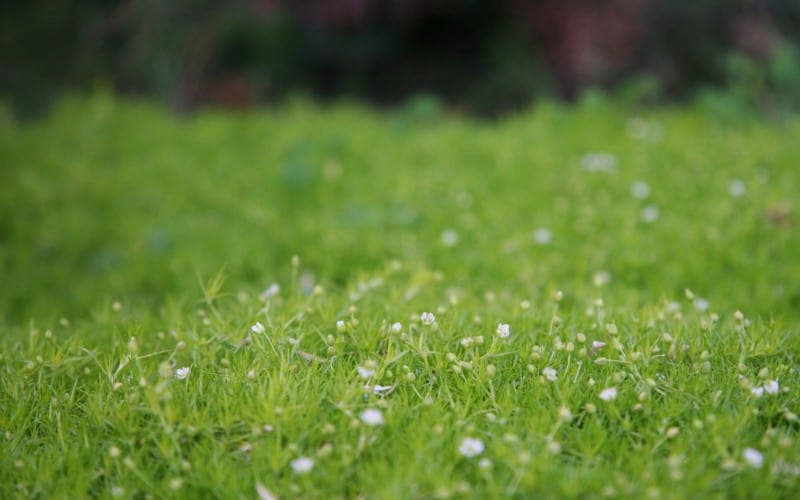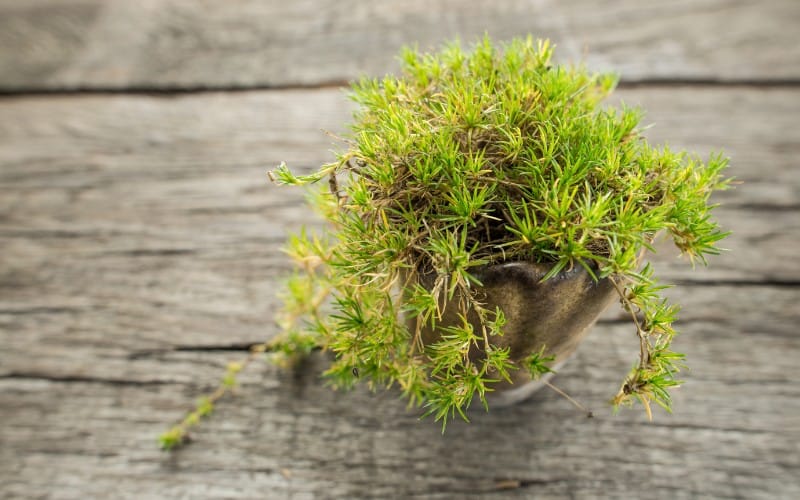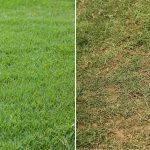Sagina subulata is the scientific name for Irish moss ground cover plant. Irish moss is a low-growing prostrate perennial ground cover plant forming a thick, dense mat with stems less than 10 cm long, and slender awl-shaped leaves of about 1 cm long, covering thin, creeping stems.
This low growing groundcover will get tiny white blooms on it during the summer months when small, star-shaped, white flowers cover the dense tufts of slender stems from late spring until mid-summer.
Also known as heath pearlwort, the Irish moss ground cover grows best in full sun or partial shade. The evergreen mossy plant foliage grows just 2 - 3 inches tall. It is perfect to behold between flagstones, stepping stones, or spilling over rocks.
Table of Contents
Irish Moss Origin, Distribution Growing Zones
This ground cover is also one of the few groundcovers used as a lawn alternative or substitute. The petite, star-shaped flowers of Irish moss are known to produce a pleasant fragrance in the spring.
A member of the Caryophyllaceae family, the Irish moss ground cover plant is native to temperate areas of western and central Europe.
The plant stretches roots from Iceland to Spain and Finland out to Romania. It has traces in Scotland, the Lake District, Wales, the Southwest and South of England, and western Ireland's coasts.
In Ireland, on Mount Brandon in County Kerry, it grows up to 700 m (2,300 ft), and even higher altitudes on Ben Lawers in Perthshire.
This plant will thrive in USDA plant hardiness zones 4 -10, depending on which variety you are growing. Having such a wide variety of growing zones makes room for a multitude of gardeners to be able to enjoy this remarkable plant.
When cultivated in the colder climate zones, it can tolerate brighter sun. But when grown in the hotter climate zones, it will require more protection from the hot afternoon sun.
The Irish moss can withstand a moderate level of foot traffic, a feature that makes for a great plant to beautify a walkway or even to be used in a lawn.
How to Grow Irish Moss Ground Cover Plant

Consider planting your Irish moss in spring, when the danger of frost is passed. When you do, plant Irish Moss seeds in starter flats. Press the tiny seeds into the soil but do not cover. At a 64 - 72F, germination takes place between 14 - 21 days.
A transplant from a nursery into the garden 6 - 9 inches apart. Set out plants 6 inches apart, if you wish to behold a faster cover.
According to Seedman, the emerald-green plant can be started from seed indoors or directly seeded into prepared soil, growing into a 1 to 2-inch green mat in approximately eight weeks.
Tiny star-shaped flowers start showing up beginning in late spring and appear sporadically throughout the growing season.
Then, rounded green buds on lean stalks open to expose the five rounded white petals the same length as the pointed green sepals and ten white stamens. The flowers are sprinkled individually across the bed of leaves.
This is then followed by skinny, smooth, brown, triangular seeds in oblong capsules.
The Irish Moss seeds can be directly sown into the garden or in-between stones. The ground cover seed must be kept moist with regular watering, but should not have soggy roots.
Irish Moss ground cover plant needs moisture retentive, gritty soil with good drainage. The plants are hardy above -30F degrees.
They do need some light to maintain their lush greenness, but they're not a heat-loving specimen. Put your Irish moss plants in sunny to partially shaded areas. In warmer zones, ensure that you sow where it is protected from the scorching sun.
Irish moss cover plant may turn brown during summer's hottest days, but greenness returns as temperatures fall in autumn. This plant is susceptible to browning out with too much or too little water.
The herbaceous perennial is evergreen in warmer zones, with charming tiny white blooms appear sporadically throughout the growing season.
In practice, the plant's seeds can be started indoors several weeks before the last frost's average date, or direct sown in the garden in spring. At this stage, please do your best to keep it continuously moist as seeds will take 2-3 weeks to germinate.
The Irish moss is less particular about the soil it's grown in, as long as it is temperate. Perhaps this is why the other thing it dislikes as much as wet feet is drought.
A low growing specimen, each unique Irish moss plant will eventually spread to cover about 1 foot. The plant grows at a moderate rate but may take several years to fill an area. Under favorable conditions, they will readily self-sow but is easy to remove in unwanted spaces.
At the age of maturity, the Irish moss will spread by self-sowing seeds, which reveals the plant's potential to become a weed. Thankfully, it is easy to pull out, especially when caught early.
To prevent self-sowing and spreading to undesirable areas, ensure you mow your Irish moss mats before flowers produce viable seeds
How to Care for Irish Moss Ground Cover Plant

Care for this plant is relatively simple. It features cutting out browning patches in older mats. Growing Irish moss reaches only 1 to 2 inches in height and does not need mowing when used as a lawn substitute.
Grown as a lawn replacement, it creates the effect of a moss-covered meadow. It has a slightly spongy feel to it and is very soft to walk on barefoot. Growing Irish moss is also super appealing in containers.
Use the Irish moss where a shallow, fine-textured carpet of green is desired, for example, between flagstones, around stepping stones, or at the edges of a path, since the plant tolerates only light foot traffic.
Frankly, the application of the Irish moss cover plant is limited only by your imagination. You can also use the grass-like mats to spread around pavers or to edge a rock garden.
Ensure that you fertilize sparingly to keep plants compact. High nitrogen levels can induce excessive foliar growth, so the plants become mounded rather than forming a carpet. Water, when necessary, to keep evenly moist, but not soggy.
The Irish moss plant has a few pests, non-threatening pests, but slugs can damage the plants. Other problems to avoid include Control snails and cutworms.
The plant does not require much fertilization, and too much nitrogen will cause it to form a mound instead of a mat, so do well not to feed Irish moss too frequently.
Also, the plant's clumps are susceptible to browning out with insufficient or excessive water. Irish moss requires full sun—6 or more hours of direct sunlight a day/ partial Shade—direct sunlight only part of the day, 2-6 hours to thrive properly.
Cultivating Irish moss as a ground cover reduces the time and labor of mowing and adds diversity and aesthetic appeal to your landscape. Once installed, the plant requires very little maintenance while adding ecological value to your environs.
It is a versatile plant and can be grown in various areas, ranging from indoors to outdoors, in a planting container, or even in a terrarium. The plant is an excellent alternative in places where it is difficult to grow grass.
According to the University of Maryland Extension, growing ground covers like Irish moss can help provide pollinators' habitat and reduce climate change.
The working tools you will need:
The work items required for the proper growth and of the Irish moss ground cover plant include:
- Hand gloves
- Rubber Farm boots (optional)
- Garden shears/ trimming scissors.
- Shovel, hoe, rototiller, or any other garden tool
- Garden or leveling rake
- Measuring tape
- Organic matter soil amendment
- Suitable fertilizer
Use Irish or Scotch moss for contrast in smaller containers or simulate a lawn in miniature or fairy gardens. The bright chartreuse-yellow color of Scotch moss provides a brilliant contrast with plants with darker green foliage.
Green or golden forms can be used as a ground cover around smaller spring-flowering bulbs such as crocus, snowdrops (Galanthus), or small fritillarias (such as Fritillaria michailovskyi or F. Meleagris).
Trying to create a patchwork or checkerboard of the green and gold types is a real challenge as they readily grow together to dilute the effect.
Recommended Reading:
- How to Grow Blue Star Creeper
- Difference Between Blue Star Creeper and Creeping Thyme
- Best Companion Plants for Blue Star Creeper
Conclusion
Having read this article, you'd have realized that contrary to what its name implies, the Irish moss is indeed not an actual moss. Instead, it is a low-growing herbaceous perennial plant similar in the habit of growth and appearance to a moss.
It is a highly sought-after choice for gardeners, providing a beautiful finishing touch and fulfilling a wide array of garden visions.
It is a low growing perennial that forms a dense mat of growth, with small, white, five-petaled daisy-like flowers that protrude from skinny several centimeter-long stems.
The stems of the plant rarely exceed 10 centimeters in length. And have leaves that extend from the branches, reaching between 1 and 2 centimeters long. The stupefying green color is eye-enchanting and will maintain its lushness, year-in, year-out, under the right conditions.




